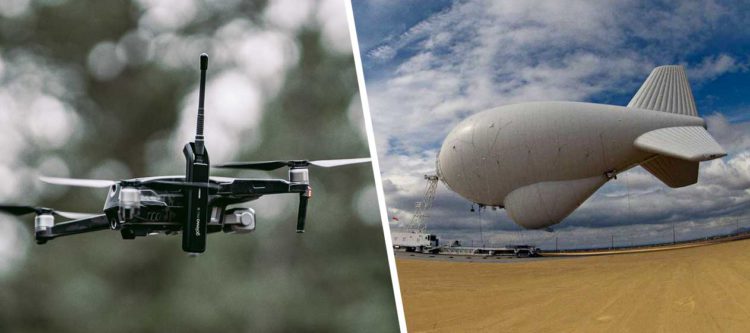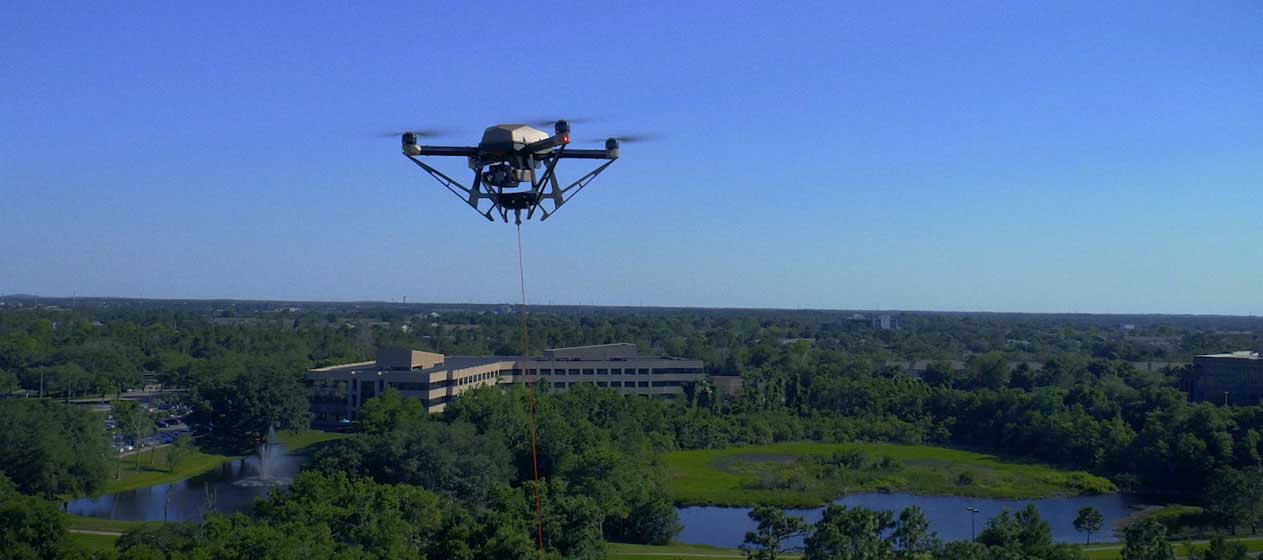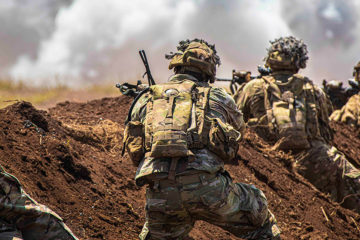Hot Take: Drones vs. aerostats for extending a mesh network


As part of the Hot Takes series, we’ll be taking a highly debated topic and exploring the pros and cons of both sides. During each debate, you’ll hear from goTenna experts who offer hands-on experience from working with customers and deploying goTenna Pro X devices in the field. Leave a comment below, or sign up for a future debate!
Drones and aerostats are both excellent tools that are utilized by military and law enforcement organizations for a number of missions and operations.
The Last Mile recently asked goTenna team members Bryant Guerrin and Luke Stewart to share their perspectives on aerostats and drones.
Bryant served in the U.S. Army for nine years, where he gained leadership experience in stressful global environments while forging relationships to support operations worldwide. Now a civilian, Bryant is a Senior Forward Deployed Engineer at goTenna.
Luke also served in the U.S. Army. He also has hands-on experience as a former firefighter, and police dispatcher. As a civilian, Luke is currently the Director of Customer Experience at goTenna. In his previous contributions to The Last Mile, Luke has covered why firefighters should look to UAVs when it comes to the future of fighting wildland fires and why radios sometimes fall short when battling a wildfire. He’s also participated in prior Hot Takes on “GPS Trackers versus goTenna Pro X” and “Where should goTenna fall within a Pace Plan?”

Drones
It can be difficult to discuss the pros and cons of using a drone for signal relay because there are different kinds of drones that operate very differently. Depending on the type of drone, they can differ greatly in-flight duration, mobility, and other characteristics that could impact their ability to function as a viable mobile mesh networking relay.
For example, there are both tethered and untethered drones that are utilized by the military and law enforcement community for ISR and communications. The most obvious difference between tethered and untethered drones is that tethered drones require a physical link to provide power, while untethered drones do not need to carry a primary power source. While both tethered and untethered drones are wildly popular and easily accessible, they have distinct differences that ultimately affect the use case. So let’s look at the advantages that both untethered and tethered drones bring to the table as a communications relay, and then look at them individually.
Tethered and Untethered
Both tethered and untethered drones excel as a communications relay when a specific communications window must be met. That’s because they can be deployed very quickly – often within one minute – and then brought down quickly. This rapid deployment is aided by the fact that many within the law enforcement community and military already are using drones – either untethered or tethered – for other use cases, including ISR.
Most tethered and untethered drones tend to be more modern, innovative, and advanced platforms than the average aerostat. They feature built-in GPS capability and other sensors that can natively integrate with other technologies in use in the field. When integrated with a goTenna device, that drone sensor data and information can be easily distributed to the entire team. Many tethered and untethered drones also have built-in sensors to make them more effective and stabilized in wind, which is something that many aerostats struggle with.
Now, let’s look at some of the specific advantages that each different type of drone can deliver.
Tethered
Tethered drones are relatively light and transportable. Although they have a 3ft x 3ft base station, the drone itself is still rather small. Tethered drones also have a dedicated power source designed to be a portable antenna, which has video connections and additional capabilities.

With the tether providing uninterrupted power to the drone, a tethered drone can stay in the air almost indefinitely. Although this approach does require power to be provided to the base station, which may not always be available in off-grid environments and at the tactical edge. This is superior to untethered drones which rely on battery power and often can only fly for a small period of time. If a mobile mesh networking relay point is needed for an extended period of time, the untethered drone is clearly superior, and is more competitive to the long life that an aerostat can deliver.
However, tethered drones are not without their shortcomings. A tethered drone will always sense the location of its base and hover over it. This can create challenges when trying to position a relay in an open area in or above dense canopy, where it would be most effective.
Regarding costs, the tethered drone has a wide range of price points, which makes it more accessible to a variety of users, but they can be more expensive options – especially in contrast to the low-priced aerostat options that are available. However, if you can transport a tethered drone, costs aren’t a factor, and there are open areas where dense canopies won’t cause an issue, tethered drones will exceed the capabilities of both untethered drones and aerostats as mobile mesh networking relays.
Untethered Drone
While the tethered drone has the advantage in power and flight duration, the untethered drone excels in mobility and flexibility. That’s because it doesn’t need to be tethered to a base station to operate.
When it comes to canopy use, untethered drones are more flexible. They have the capability to be lifted outside of the canopy and fly over it for coverage. They can also be navigated to more open areas since they don’t need to be connected to a base station.
Although untethered drones do not require an external power source, that comes with the trade-off of much smaller battery life. The average battery life of an untethered drone can is approximately 30 minutes- and once it dies it must be brought to a power source to recharge. During this time, tactical operators in the area have to live without a mobile mesh networking relay – unless a backup drone is charged and readily available.
Also, untethered drones limit other aircrafts’ abilities to fly into the usage area. Since they are mobile and small, they create collision concerns for other aircraft. That can be a problem across all government use cases, since the military relies heavily on air support, wildland firefighters often utilize planes for the targeted dispersal of large amounts of water, and law enforcement will often rely on helicopters and other aerial assets to assist in operations.

Aerostats
There are a number of reasons why government users and tactical operators might choose an aerostat to act as a communications relay over a drone.
Because of their “light” weight and small form factor when deflated, aerostats are considered more transportable. Also, since they only need to be inflated, aerostats can be just as rapidly deployable as a drone. Simply blow up an aerostat with a gas that is “lighter than air” and it immediately goes airborne. This is not only a simple operation, but one that can be done easily by anyone with virtually no training.
Unlike a drone, aerostats don’t require a dedicated power source. This means they don’t need to be tethered to a base station for long flight durations. They also don’t need to be brought down to Earth to charge every 30 minutes or so like an untethered drone.
Unlike tethered drones, whose altitude is limited to the length of the tether, aerostats can be operated at high altitudes and can be sent to clear areas above the canopy. This increases line of sight and range, making them better options as communications relays for large areas of operation.
Aerostats are also relatively immobile when put into the air. They’re sent to the desired altitude and then often tied down for station keeping. Unlike the tethers that connect tethered drones, the tethers used for aerostats can be any length, because they’re often just ropes or cables that keep the aerostat in place. And the ability to tether an aerostat and keep it in one place drastically reduces the chance for collision with other aircraft in comparison to untethered drones. That opens the door to providing air support for warfighters, law enforcement personnel, wildland firefighters, and first responders.
When it comes to cost comparisons, it can be difficult to compare aerostats to drones because there is such a wide ecosystem of aircraft that can be considered aerostats. While some aerostats have a significantly higher price point than drones, with some beginning at $60,000, there are some weather balloon options that could work as mobile mesh networking relays and average between $30 to $50.

Then there’s the challenge of inflating an aerostat. Helium usage can be contingent upon weather as cold climates shrink helium, which decreases the lift. This also requires the user to transport a helium tank. Depending on the aerostat’s size and payload, the overall weight of that tank could be significant.
If you’re only transporting a goTenna with the aerostat, you won’t incur a major weight difference given its convenient size, however, if you intend to also include a camera, you will need to carry larger balloons and more helium tanks. However, a positive highlight is that aerostats are no longer limited to helium, as there are many field-expedient hydrogen options available.
While a tethered drone and an aerostat have many of the same advantages and disadvantages as mobile mesh networking relays, an aerostat like a weather balloon can be an inexpensive, rapidly-deployable, and easy to operate method for getting a goTenna Pro X device to high altitudes. When compared to an untethered drone, its ability to stay deployed almost indefinitely delivers a massive advantage over the short battery life and constant recharges that the drone requires.
Aerostats might not be the most technologically advanced alternative, but they’re already in use for many military, law enforcement, and emergency response missions, and they can be a viable vehicle for blanketing an area of operations with connectivity and communications. Just because they’re not the latest and greatest doesn’t mean they can’t do the job, and do it effectively.
Disclaimer: Please note, for all aerial assets, be sure to follow any applicable government regulations and restrictions during your deployment.







No Comment